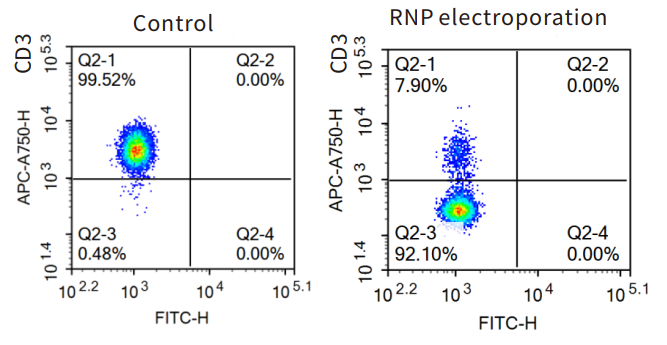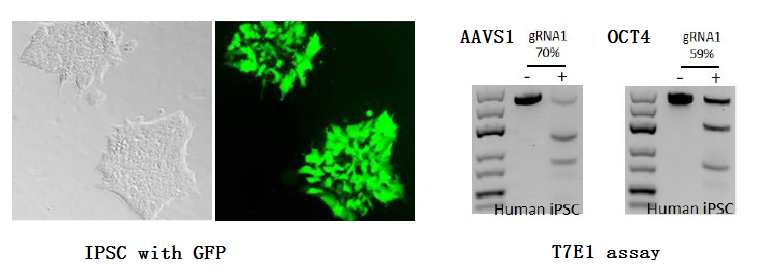- Electroporation by Celetrix
- Genome Editing
Genome editing by CRISPR/Cas9
With Celetrix electroporation, we can deliver RNP (ribonucleoprotein complex containing Cas9 protein and gRNA) or Cas9/gRNA plasmid into cells to perform gene editing.
RNP electroporation has very low cell toxicity and the efficiency of gene editing can usually reach over 90%, with no apparent cell type limitation. For primary T cells, NK cells and stem cells, Cas9 plasmids have a high toxicity upon electroporation and we recommend using RNP on these cells.
T cell gene editing can be done with either unstimulated T cells (PBMC) or stimulated T cells, using different voltages. On the LE+/EX+ model machines, we can use the PBMC mode to electroporate RNP into PBMCs with a high voltage. Stimulated T cells are electroporated at 2-3 days of stimulation time and the voltage is similar to common cell lines, much lower than the voltage of PBMCs. For example, we can knock out the TCR using 2-3 day stimulated T cells and the efficiency of knockout is 92% and cell growth is not impaired.

T cell, NK cell and CD34+ HSC cells are important for gene and cell therapy applications. Our technical support can make gene editing in these cells very straightforward for you. Also, we have a large scale single tube electroporation machine that can process a 10 ml sample, or 2x10E9 cells in a single zap.
iPSC cells are also similar to common cell lines with Celetrix electroporation. RNP electroporation can achieve high efficiency gene editing in iPSCs, as shown with AAVS1 and OCT4 genes. One easy way to achieve high gene editing efficiency is to use relatively high concentration of RNP, such as 10 ug Cas9 and 5 ug gRNA in a 20 ul electroporation.

Plasmid based gene editing is suitable for cell lines. The cell toxicity of large plasmids containing Cas9 gene and gRNA gene can be tolerated by cell lines. The gene editing efficiency from plasmid electroporation is usually lower than the efficiency from RNP electroporation. However, we can use drug resistant gene selection to improve the gene editing efficiency. For example, THP-1 cells was electroporated with a plasmid containing Cas9, gRNA, GFP and puromycin-resistance genes and cells were all positive in GFP after puromycin selection, with a high rate of gene editing.

Normally it takes long time to do gene editing with plasmids. We have developed protocols to perform quick gene editing, even with plasmids. Because of the high cell viability and efficiency of Celetrix electroporation, drug selection can be done for a short period at the transient transfection stage and the remaining cells carry gene editing without stable integration of the plasmid. This new method speeds up plasmid based gene editing and allows sequential editing of multiple genes.
